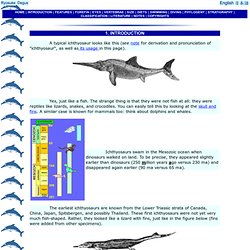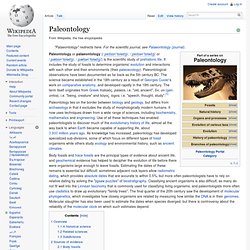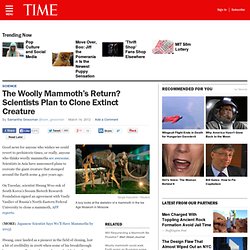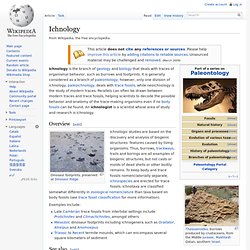

Introduction. 1.

INTRODUCTION A typical ichthyosaur looks like this (see note for derivation and pronunciation of "ichthyosaur", as well as its usage in this page). Yes, just like a fish. The strange thing is that they were not fish at all: they were reptiles like lizards, snakes, and crocodiles. You can easily tell this by looking at the skull and fins.
A similar case is known for mammals too: think about dolphins and whales. National Museum of Natural History - Dinosaurs. Paleontology. Paleontology or palaeontology (/ˌpeɪlɪɒnˈtɒlədʒi/, /ˌpeɪlɪənˈtɒlədʒi/ or /ˌpælɪɒnˈtɒlədʒi/, /ˌpælɪənˈtɒlədʒi/) is the scientific study of prehistoric life.

It includes the study of fossils to determine organisms' evolution and interactions with each other and their environments (their paleoecology). Paleontological observations have been documented as far back as the 5th century BC. The science became established in the 18th century as a result of Georges Cuvier's work on comparative anatomy, and developed rapidly in the 19th century. The term itself originates from Greek παλαιός, palaios, i.e. "old, ancient", ὄν, on (gen. ontos), i.e. Paleontology lies on the border between biology and geology, but differs from archaeology in that it excludes the study of morphologically modern humans. Overview[edit] A historical science[edit] Related sciences[edit] Analyses using engineering techniques show that Tyrannosaurus had a devastating bite, but raise doubts about how fast it could move.
Chronology of Geography, Meteorology, Paleontology, Science Philosophy, and Science Publishing.
Primates. Evolution: Extinction. Vendian Animals. The Paleontology Portal: Home. Resurrecting the Woolly Mammoth? Scientists Plan to Clone the Extinct Creature. Good news for anyone who wishes we could revert to prehistoric times, or really, anyone who thinks woolly mammoths are awesome.

Scientists in Asia have announced plans to recreate the giant creature that stomped around the Earth some 4,500 years ago. On Tuesday, scientist Hwang Woo-suk of South Korea’s Sooam Biotech Research Foundation signed an agreement with Vasily Vasiliev of Russia’s North-Eastern Federal University to clone a mammoth, AFP reports. (MORE: Japanese Scientist Says We’ll Have Mammoths by 2015) Hwang, once lauded as a pioneer in the field of cloning, lost a bit of credibility in 2006 when some of his breakthrough human stem cell research turned out to be fabricated.
However, experts have verified his work in creating the world’s first cloned dog, Snuppy, in 2005. So how exactly does one go about cloning a woolly mammoth? Cambrian Explosion. Most major animal groups appear for the first time in the fossil record some 545 million years ago on the geological time scale in a relatively short period of time known as the Cambrian explosion. Of great worry to Darwin, the explanation of this sudden, apparent explosion persists as a source of numerous major debates in paleobiology. While some scientists believe there was indeed an explosion of diversity (the so-called punctuated equilibrium theory elaborated by Nils Eldredge the late Stephen J. Cambrian explosion. The Cambrian explosion has generated extensive scientific debate.

The seemingly rapid appearance of fossils in the “Primordial Strata” was noted as early as the 1840s,[14] and in 1859 Charles Darwin discussed it as one of the main objections that could be made against the theory of evolution by natural selection.[15] The long-running puzzlement about the appearance of the Cambrian fauna, seemingly abruptly and from nowhere, centers on three key points: whether there really was a mass diversification of complex organisms over a relatively short period of time during the early Cambrian; what might have caused such rapid change; and what it would imply about the origin of animal life. Interpretation is difficult due to a limited supply of evidence, based mainly on an incomplete fossil record and chemical signatures remaining in Cambrian rocks. Key Cambrian explosion events Gaskiers glaciationArchaeonassa-type trace fossils History and significance[edit]
Evolution: Library: The Cambrian Explosion. For most of the nearly 4 billion years that life has existed on Earth, evolution produced little beyond bacteria, plankton, and multi-celled algae.

But beginning about 600 million years ago in the Precambrian, the fossil record speaks of more rapid change. First, there was the rise and fall of mysterious creatures of the Ediacaran fauna, named for the fossil site in Australia where they were first discovered. Some of these animals may have belonged to groups that survive today, but others don't seem at all related to animals we know.
Cows of the Cretaceous. Extinct Animals. Ichnology. Ichnology is the branch of geology and biology that deals with traces of organismal behavior, such as burrows and footprints.

It is generally considered as a branch of paleontology; however, only one division of ichnology, paleoichnology, deals with trace fossils, while neoichnology is the study of modern traces. Parallels can often be drawn between modern traces and trace fossils, helping scientists to decode the possible behavior and anatomy of the trace-making organisms even if no body fossils can be found. An ichnologist is a scientist whose area of study and research is ichnology. Overview[edit] Ichnologic studies are based on the discovery and analysis of biogenic structures: features caused by living organisms. Examples include: See also[edit] Bird ichnology External links[edit] Ichnos An International Journal for Plant and Animal Traces. Archaen Eon. Proterozoic eon. Phanerozoic Eon. Strange Science: The Rocky Road to Modern Paleontology and Biology. BBC Nature - Pliosaurs videos, news and facts. Image of the Day: The Oldest Supernova Explosion Ever Detected.
Astronomers have discovered the oldest and farthest supernova ever detected -- a massive star that exploded 11 billion years ago.

Introducing the palaeontology of Great Britain. A Guide to the Orders of Trilobites. Whale-eating sea monster uncovered in Peru. Leviathan melvillei chomps down on a baleen whale.

HIT PLAY, above, the see its fossilised teeth. Three lower teeth (a,b,c) of Leviathan melvillei compared to teeth of the modern sperm whale Physeter macrocephalus (d) and the modern killer whale Orcinus orca (e). Credit: G. Bianucci (Universitá di Pisa), O. Lambert (MNHN) and P. Jack Horner: Building a dinosaur from a chicken. Imaging technology reveals intricate details of 49 million-year-old spider. 18 May 2011 Scientists have used the latest computer-imaging technology to produce stunning three-dimensional pictures of a 49 million-year-old spider trapped inside an opaque piece of fossilized amber resin.

University of Manchester researchers, working with colleagues in Germany, created the intricate images using X-ray computed tomography to study the remarkable spider, which can barely be seen under the microscope in the old and darkened amber. Writing in the international journal Naturwissenschaften, the scientists showed that the amber fossil – housed in the Berlin Natural History Museum – is a member of a living genus of the Huntsman spiders (Sparassidae), a group of often large, active, free-living spiders that are hardly ever trapped in amber. “More than 1,000 species of fossil spider have been described, many of them from amber,” said Dr David Penney, from Manchester’s Faculty of Life Sciences.
“The results were surprising,” said Dr Penney. Ends Notes for editors.